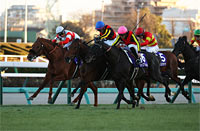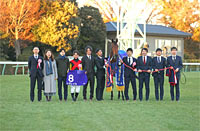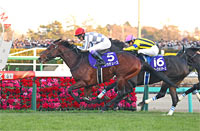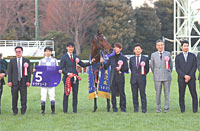2015 News
Data Analysis for the “2015 Arima Kinen (The Grand Prix) (G1)”A major national event and a popular year-end tradition Last year’s Arima Kinen was contested by a glittering lineup of racing talent – 10 of the 16 runners were previous Grade 1 winners while 5 of the remaining 6 had experienced 2nd-place finishes in Grade 1 races. The winner, Gentildonna, romped off with 200 million yen in prize money, taking her career winnings to 1,726,030,400 yen (including bonus prizes), second only to T.M.Opera O (1,835,189,000 yen) in the all-time career earning rankings. So which horse will win this dream race, boasting one of the world’s highest betting sales and prize money, to the resounding cheers of racing fans? Let’s analyze statistics shared by winners and top 3 finishers in this race from results over the last 10 years. Look for strong performers in the previous race Of the 30 Top 3 finishers over the last 10 years, 20 had finished “In the Top 4” in their previous races. By contrast, those beaten to “5th or lower” last time out have tended to struggle, managing a Top 3 ratio of only 13.5%. Basically, our focus should be on runners coming with a good finish in their previous outings. [Table 1] [Table 1] Performance by finish in the previous race (last 10 years)
What’s more, all 10 of the Top 3 finishers placed “5th or lower” last time out were horses with Top 3 experience in G1 or G2 races held at Nakayama Racecourse since the previous year. Except for those with significant past record at Nakayama, it seems we can harbor little hope of a turnaround from horses that finished “5th or lower” in their previous races. [Table 2] [Table 2] Performance of horses finishing "5th or lower" last time out, by top 3 experience in G1 or G2 races held at Nakayama since the previous year (last 10 years)
“Lower” horse numbers basically have an edge Of the 30 Top 3 finishers over the last 10 years, 16 of them had horse numbers (barrier draw numbers) in the range “1-6.” Runners in this category have also notched better success ratios than those with numbers “7-16,” including a Top 3 ratio of 27.6%. This race would seem better suited to runners with lower horse numbers. [Table 3] [Table 3] Performance by horse number (last 10 years)
Moreover, of the eight Top 2 finishers with horse numbers “7-16,” all except 2008 runner-up Admire Monarch had already experienced a Top 2 finish in a JRA G1 race since June of that year. It seems that runners with numbers “7-16” will struggle to impress unless they have the momentum and record of challenging for wins in the G1 schedule since June. [Table 4] [Table 4] Performance of horses with numbers "7-16" by Top 2 experience in JRA G1 races since June that year (last 10 years)
Discount runners aged 6+ and career veterans Of the 30 Top 3 finishers over the last 10 years, 26 were aged “5 and under.” By contrast, those aged “6 and up” not only have a poor Top 3 ratio of 11.1%, but also none except 2008 runner-up Admire Monarch (7yo) has finished in the Top 2. When comparing horses of different ages, our focus should perhaps be on the younger ones. [Table 5] [Table 5] Performance by age (last 10 years)
Also, of the 30 Top 3 finishers over the last 10 years, 24 entered the race with a total of “20 or fewer” career starts. Conversely, those with “21 or more” career starts have managed a Top 3 ratio of only 10.5%, and only two have finished in the Top 2 (2008 runner-up Admire Monarch, 44th career race, and 2009 winner Dream Journey, 23rd). So we should not expect too much of horses with a wealth of racing experience – even if they are aged “5 and under.” [Table 6] [Table 6] Performance by total career starts (last 10 years)
Check that year’s track record and distance affinity All of the 30 Top 3 finishers over the last 10 years had already experienced a Top 3 finish in a JRA 1,800-2,500m G1 or G2 race in the year in question. Horses without this kind of track record may be expected to struggle here. [Table 7] [Table 7] Performance by experience of a top 3 finish in JRA 1,800-2,500m G1 or G2 races that year (last 10 years)
Meanwhile, all of the last 10 winners had experienced a Top 3 finish in a JRA 2,000-2,200m G1 or G2 race (not including fillies-only races) in the year in question. Horses in this category also have high success ratios, including a Top 3 ratio of 31.2%. It seems we can place relatively strong reliance on horses with experience of good performances in races under these conditions in the same year. [Table 8] [Table 8] Performance by experience of a Top 3 finish in a JRA 2,000-2,200m G1 or G2 race (not including fillies-only races) in the year in question (last 10 years)
Strong showing by horses with experience of performing well on steep, sloping courses All of the last 10 winners had experienced Top 3 finishes in 2,000-2,400m G1 or G2 races held since the previous year at Nakayama, Hanshin or Chukyo (the latter only counting records since its refurbishment in 2012) Racecourses. Horses with this experience have far better success ratios than those without, including a Top 3 ratio of 27.4%. And if we limit our analysis to the last 5 years since 2010, their performance is [5-5-4-32], with an even better Top 2 ratio (21.7%) and Top 3 ratio (30.4%). Runners with experience of strong performance on courses with a steep uphill slope on the home straight should be evaluated highly. [Table 9] [Table 9] Performance by experience of Top 3 finishes in 2,000-2,400m G1 or G2 races held since the previous year at Nakayama, Hanshin or Chukyo (since 2012 only) (last 10 years)
Seek out the winner! All of the last 5 winners had finished in the Top 4 in their previous races, were aged 5 years old or under, and had contested no more than 20 career starts. Other points shared by these horses are that they had all experienced a Top 2 finish in a JRA 2,000-2,200m G1 or G2 race (not including fillies-only races) in the year in question, and had experienced a Top 3 finish in a 2,000-2,400m G1 or G2 race held since the previous year at Nakayama or Hanshin Racecourse. Any runner meeting the conditions set in Table 1, Table 5, Table 6, Table 8 and Table 9 could be seen as a leading contender to win this race. [Table 10]
[Table 10] Data of winning horses in the last 5 years (“Finish in previous race,” “Age,” “Career starts,” “Highest finish in JRA 2,000-2,200m G1 or G2 races (not including fillies-only races) in the same year,” and “Highest finish in 2,000-2,400m G1 or G2 races held since the previous year at Nakayama or Hanshin”)
* (Japanese 2,000 Guineas) (Data analysis by Masaya Ibuki) |

|



















